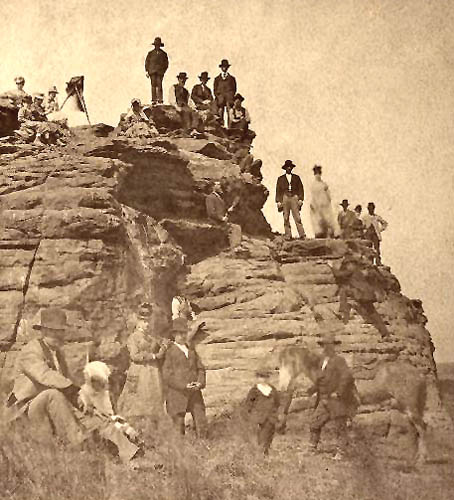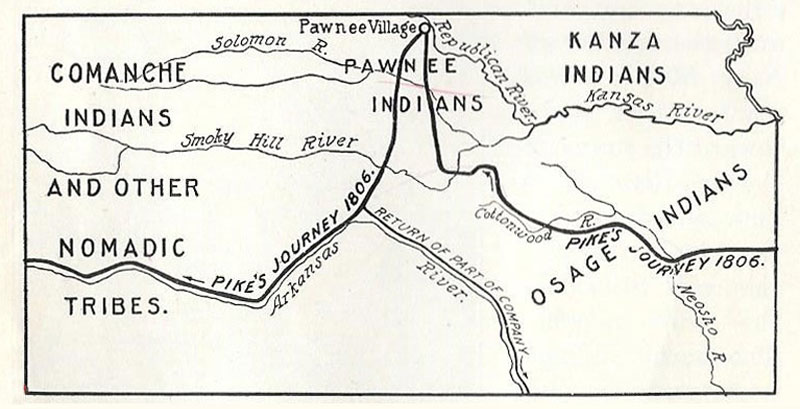
Pawnee Rock: A Sentinel on the Prairie, Echoing Tales of Conflict and Passage
In the vast, undulating expanse of central Kansas, where the prairie stretches to meet an endless sky, a solitary sandstone outcrop rises abruptly from the flatlands. This geological anomaly, known as Pawnee Rock, is more than just a striking feature on the landscape; it is a sentinel, a silent witness to centuries of human drama, a nexus where the ambitions of westward expansion clashed with the ancestral claims of Indigenous peoples. The story of Pawnee Rock, intertwined with the legends of Native American resilience and the arduous journey of the Santa Fe Trail, encapsulates a pivotal chapter in American history, resonating with both triumph and tragedy.
Rising some 50 to 60 feet from the prairie floor, Pawnee Rock, a remnant of the Dakota Formation, once commanded an unparalleled view for miles in every direction. For millennia, long before the arrival of European explorers and American pioneers, this natural fortress was a strategic lookout for the Indigenous tribes who roamed these lands. The Cheyenne, Arapaho, Comanche, Kiowa, and indeed, the Pawnee themselves, understood its value. From its summit, hunters could spot buffalo herds, warriors could detect approaching enemies or rival tribes, and sentinels could signal the presence of game or danger. It was a place woven into the fabric of their lives, a part of their ancestral domain where survival depended on an intimate knowledge of the land.
The name "Pawnee Rock" itself is steeped in the history of these early inhabitants. While its precise origin is debated, one popular theory suggests it was a favored hunting ground or a place where the Pawnee tribe frequently camped or engaged in battles with other tribes. Another account posits it was the site of a significant skirmish between the Pawnee and the Osage, or perhaps a place where the Pawnee gathered before raids. Regardless of the exact etymology, the name irrevocably links the rock to the Native American presence that predated, and for a long time, defined the Kansas plains.

With the dawn of the 19th century, the quiet dominion of the Indigenous peoples began to be challenged by a new force: American expansion. The Santa Fe Trail, established in 1821, became a vital artery for trade, connecting the burgeoning United States with the distant markets of Santa Fe, New Mexico. Stretching over 900 miles of unforgiving terrain, the trail was a lifeline for commerce, but also a conduit for conflict. Pawnee Rock, situated roughly halfway along the trail in what is now Barton County, Kansas, quickly became one of its most iconic and treacherous landmarks.
For the thousands of traders, soldiers, and settlers who traversed the trail, Pawnee Rock served as both a beacon of hope and a harbinger of danger. Its distinctive silhouette on the horizon was a welcome sight, signaling a significant milestone in their arduous journey. Many travelers, seeking a moment of respite or a vantage point, would climb its rocky slopes, often carving their names and dates into the soft sandstone, leaving behind a permanent register of their passage. These inscriptions, some still faintly visible today, offer a tangible link to the pioneers of old, a testament to their courage and endurance.
However, the rock’s strategic value was not lost on the Native American tribes whose lands were increasingly encroached upon by the relentless flow of wagons. From their perspective, the trail was not merely a path for commerce but an invasion, a relentless assault on their way of life. The massive buffalo herds, central to their survival and culture, were being decimated by market hunters and trail travelers. Their sacred lands were being trampled, and their resources depleted. Pawnee Rock, with its commanding view, became a prime location for these tribes to observe, and sometimes ambush, the passing caravans.
"This is the most dangerous point on the whole road," warned one early frontiersman, a sentiment echoed in countless diaries and letters of the era. The terrain around Pawnee Rock, with its scattered trees and broken ground, offered ideal cover for surprise attacks. Traders, often laden with valuable goods, were vulnerable targets. Skirmishes were frequent and often brutal. A band of Cheyenne might swoop down from the rock, intent on capturing horses, supplies, or demonstrating their fierce determination to protect their territory. The sound of war cries, the thundering hooves of horses, and the crack of rifles became an all too common symphony in the vicinity of Pawnee Rock.
To counter these threats, the U.S. Army established a series of forts along the Santa Fe Trail, including Fort Larned, located a relatively short distance southwest of Pawnee Rock. Soldiers from these outposts often patrolled the trail, escorting caravans and engaging in skirmishes with Native American warriors. Yet, despite military presence, the danger remained palpable. The vastness of the prairie made effective policing nearly impossible, and the determination of the Indigenous peoples to resist the invasion of their lands was unwavering.
The period from the 1840s through the 1860s marked the peak of these conflicts. The "Indian Wars" on the plains were not isolated incidents but a systemic clash of cultures, economies, and worldviews. For the Native Americans, these were wars of survival, fought to preserve their way of life against an overwhelming tide. For the American settlers and soldiers, they were a necessary, albeit often brutal, part of "taming the frontier" and fulfilling the doctrine of Manifest Destiny. Pawnee Rock stood as a stark symbol of this protracted struggle, a silent monument to the lives lost on both sides.
One particularly vivid, though perhaps apocryphal, story associated with Pawnee Rock speaks to the constant threat. It is said that in 1848, a group of travelers was besieged by a large band of Native American warriors at the base of the rock. Outnumbered and outgunned, they prepared for their last stand. However, a sudden, violent thunderstorm swept across the prairie, forcing the attackers to withdraw, allowing the beleaguered travelers to escape under the cover of the deluge. While the specifics may vary in retelling, such tales illustrate the ever-present danger and the precariousness of life on the frontier.
By the late 1860s and early 1870s, the tide of conflict had decisively turned. The construction of the transcontinental railroad, which bypassed much of the Santa Fe Trail, the decimation of the buffalo herds, and sustained military campaigns gradually broke the power of the Plains tribes. Treaties, often broken or unfair, confined many to reservations. The era of the open prairie and the free-ranging Indigenous nations drew to a close. Pawnee Rock, once a critical strategic point, lost its military significance. The flow of wagons dwindled, replaced by the iron horse and the steel tracks that brought a new wave of settlers and fundamentally altered the landscape.

Today, Pawnee Rock stands as a Kansas State Historic Site, a monument to a bygone era. Visitors can still climb its weathered slopes, gaze out across the endless plains, and try to imagine the scenes that unfolded here centuries ago. The wind whispers through the sparse vegetation, carrying echoes of both the brave pioneers who carved their names into the rock and the Indigenous warriors who fiercely defended their homeland.
The narrative surrounding Pawnee Rock has evolved over time. While early accounts often glorified the "pioneer spirit" and portrayed Native Americans primarily as obstacles to progress, contemporary understanding strives for a more nuanced and inclusive history. Historians and educators now emphasize the profound loss experienced by Indigenous peoples, acknowledging the devastating impact of westward expansion on their cultures, lands, and populations. Pawnee Rock, therefore, serves not only as a reminder of the Santa Fe Trail’s challenges but also as a somber testament to the sacrifices and struggles of the Native American tribes.
In its enduring silence, Pawnee Rock challenges us to reflect on the complex tapestry of American history. It invites us to consider the courage of all who traversed its shadow – the resilient Indigenous nations, the hopeful pioneers, the intrepid traders, and the weary soldiers. It reminds us that the land itself holds stories, etched not just in rock, but in the collective memory of a nation striving to reconcile its past. As the Kansas sun continues its daily arc over this ancient sentinel, Pawnee Rock remains a powerful, tangible link to a pivotal era, a place where the spirit of the prairie still whispers tales of courage, conflict, and the enduring human journey.
.jpg?w=200&resize=200,135&ssl=1)

